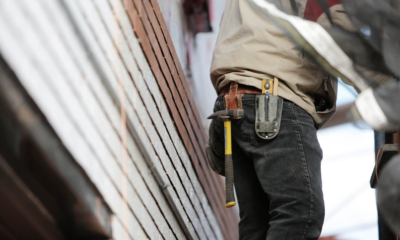Lifestyle
From Forest to Fireplace: Understanding the Eco-Friendly Benefits of Wood Heating
Published
4 months agoon
By
Robert King
Wood heating has been a traditional method of keeping homes warm for centuries. While it may seem like an outdated practice in today’s world of central heating systems and electric heaters, wood heating offers a range of eco-friendly benefits that make it a compelling choice for environmentally-conscious homeowners. In this comprehensive guide, we’ll explore the journey of wood from forest to fireplace and delve into the sustainable advantages of using wood as a heating fuel.
The Sustainability of Wood
Wood is inherently sustainable due to its renewable nature. Unlike fossil fuels, which are finite resources, trees can be replanted and harvested cyclically, ensuring a continuous supply. Sustainable forestry practices, such as selective harvesting and replanting, help maintain the health and biodiversity of forests while providing a renewable source of wood fuel. Additionally, wood is considered carbon-neutral, as the carbon dioxide released during combustion is balanced by the carbon absorbed by trees during their growth. By utilizing wood heating and supporting responsible forestry management, individuals can reduce their environmental impact and contribute to a more sustainable future.
1. Renewable Resource
One of the primary reasons wood heating is considered eco-friendly is because wood is a renewable resource. Unlike fossil fuels such as coal, oil, and natural gas, which take millions of years to form and are finite in supply, trees can be replenished through sustainable forestry practices. When managed responsibly, forests can be harvested for timber without depleting the ecosystem.
2. Carbon Neutrality
When burned, wood releases carbon dioxide (CO2) into the atmosphere, contributing to greenhouse gas emissions. However, unlike fossil fuels, which release carbon stored deep underground for millions of years, wood is considered carbon-neutral. This is because the carbon released during combustion is offset by the carbon absorbed by trees during their growth phase. As long as new trees are planted to replace those harvested for firewood, wood heating can maintain a carbon-neutral cycle.
3. Sustainable Forestry Practices
To ensure the sustainability of wood as a heating fuel, it’s essential to practice responsible forestry management. Sustainable forestry practices include selective harvesting, replanting of trees, protection of wildlife habitats, and minimizing soil erosion. When done correctly, these practices help maintain the health and biodiversity of forests while allowing for the continued production of wood fuel.
- Selective Harvesting: Only mature trees are harvested, allowing younger trees to continue growing and contributing to carbon sequestration.
- Replanting: After harvesting, trees are replanted to replenish the forest and maintain its productivity.
- Habitat Protection: Forest management plans include measures to protect wildlife habitats, streams, and other sensitive ecosystems.
- Soil Conservation: Techniques such as erosion control and buffer zones help minimize soil erosion and preserve soil health.
The Eco-Friendly Benefits of Wood Heating
Wood heating offers a range of eco-friendly benefits that make it an attractive choice for environmentally-conscious individuals. Firstly, wood is a renewable resource, replenished through sustainable forestry practices. Secondly, wood heating is carbon-neutral, as the carbon dioxide released during combustion is offset by the carbon absorbed by trees during their growth. Additionally, wood heating promotes energy independence by relying on a locally available and renewable resource. Furthermore, the wood heating industry supports rural economies by creating jobs in the forestry, processing, and transportation sectors. Lastly, using wood as a heating fuel helps reduce waste by utilizing timber that would otherwise be discarded.
1. Reduced Carbon Emissions
While wood heating does release carbon dioxide into the atmosphere, the overall carbon footprint is lower compared to fossil fuels when considering the carbon-neutral cycle of trees. By using sustainably sourced firewood and modern, efficient wood-burning appliances, homeowners can significantly reduce their carbon emissions and contribute to mitigating climate change. Overall, wood heating offers a sustainable and environmentally friendly alternative to conventional heating fuels, especially when coupled with 100% natural firelighters.
2. Energy Independence
Wood heating provides homeowners with a degree of energy independence, as it relies on a locally available and renewable resource. Unlike fossil fuels, which are subject to price fluctuations and geopolitical tensions, wood can be sourced locally, reducing reliance on external energy suppliers.
3. Support for Rural Economies
The wood heating industry supports rural economies by creating jobs in forestry, processing, transportation, and retail sectors. By choosing wood heating, homeowners can contribute to the vitality of rural communities and support sustainable land management practices.
4. Waste Reduction
Using wood as a heating fuel can help reduce waste by utilizing timber that would otherwise be left to rot or disposed of as waste. By turning wood waste into heat energy, homeowners can minimize the environmental impact of forestry operations and reduce the need for landfill space.
The Journey of Wood: From Forest to Fireplace
The journey of wood from the forest to the fireplace encompasses several stages. It begins with the careful harvesting of trees from managed forests, followed by processing to produce firewood of the desired size and moisture content. Processed firewood is then transported to retailers or consumers for use in wood-burning appliances. Finally, the wood is burned in a stove, fireplace, or boiler to provide heat energy. Each stage of the journey involves opportunities for sustainable practices, from selective harvesting to efficient combustion. By understanding the journey of wood, individuals can make informed choices that support responsible forestry management and reduce their environmental footprint.
1. Harvesting
The journey of wood heating begins in the forest, where trees are carefully selected and harvested for timber. Sustainable forestry practices dictate which trees can be cut down based on factors such as age, size, and species. Selective harvesting ensures that the forest ecosystem remains intact and capable of regenerating naturally.
2. Processing
Once harvested, the timber is transported to processing facilities where it is cut, split, and seasoned into firewood. Seasoning involves allowing the wood to dry naturally, typically for six months to a year, reducing its moisture content and making it suitable for burning. Seasoned firewood produces less smoke and burns more efficiently than green or wet wood.
3. Transportation
From processing facilities, firewood is transported to retailers or directly to consumers for use in wood-burning stoves, fireplaces, or wood-fired boilers. Local sourcing of firewood minimizes the carbon footprint associated with transportation and supports the local economy.
4. Combustion
When burned in a wood-burning appliance, such as a stove or fireplace, firewood releases heat energy through combustion. The heat generated can be used to warm homes, heat water, or even generate electricity in wood-fired power plants. Modern wood-burning appliances are designed to maximize efficiency and minimize emissions, making them a cleaner and more sustainable heating option compared to older, inefficient models.
Summing Up
From its origins in the forest to its warmth in the fireplace, wood heating offers a sustainable and eco-friendly alternative to conventional heating fuels. By embracing responsible forestry practices, efficient wood-burning appliances, and local sourcing of firewood, homeowners can reduce their carbon footprint, support rural economies, and enjoy the comforting warmth of a wood fire. As we strive to mitigate the impacts of climate change and build more resilient communities, wood heating stands out as a renewable and environmentally-conscious choice for heating our homes.
Recent News


4 Amazing Trips for Your Family
Choosing somewhere for a family vacation that would pique the attention of adults and kids alike can be a fun...


Customising Your Makeup with Blendable Blush Options
In cosmetics, one’s face is a canvas for self-expression and creativity. Among the myriad of products available, blush is a...


The Benefits of Regular Home Maintenance
Regular home maintenance is essential for maintaining and even raising the value of your house. A proactive approach to repairs...


Understanding the Importance of SEO in Adelaide
In the digital marketplace, Adelaide businesses are in a continuous contest to gain the attention of their target audiences. With...


Breaking Down the Numbers: Understanding the Average Traveling Nurses Pay
The open road, adventure, and the chance to heal – travel nursing promises an undeniable allure. But amidst the excitement,...


Dealing with Oily Skin in Summer: Tips and Tricks
As the temperature rises, those with oily skin often face an additional challenge—maintaining a clear and balanced complexion. Excess oil...


Mountain Wedding Ideas for 2024
A mountain wedding is a stunning choice for couples who cherish nature and desire a distinctive wedding experience. Whether you...


3 Of The Best Ways To Keep Your Salon Clean
It is of the utmost importance to ensure that a salon is kept scrupulously clean, not just for the sake...


3 Reasons You Should Get Blood Tests Every Year
Regular blood tests are essential for preserving general health and identifying potential problems early on. Medical professionals can evaluate your...


How to Make Your Next Crafts Project Pop
Crafting is a creative outlet that allows individuals to express themselves through various mediums such as paper crafts, sewing, painting,...
